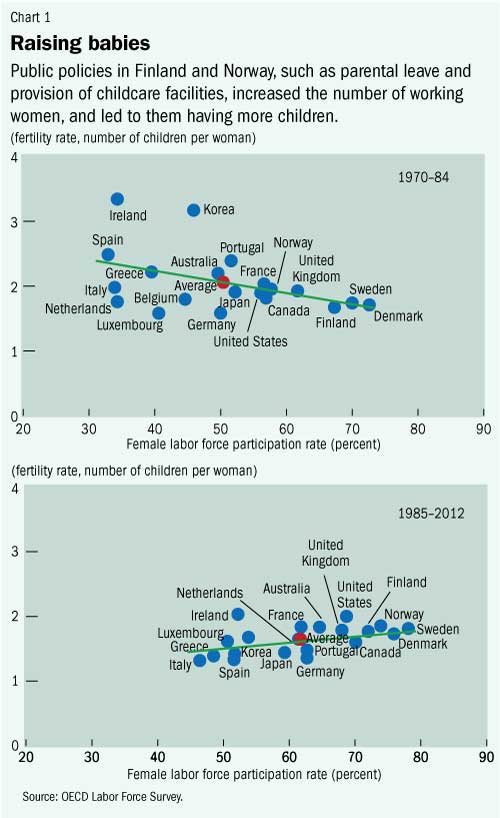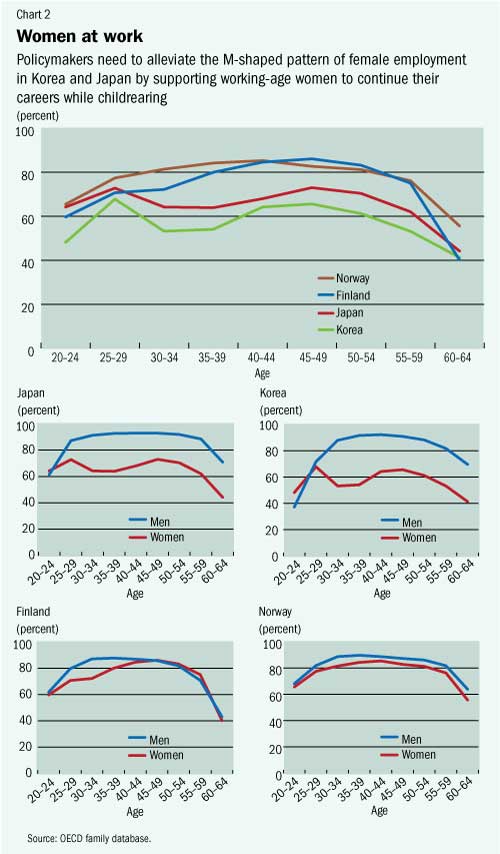
Typical street scene in Santa Ana, El Salvador. (Photo: iStock)
IMF Survey : Nordic Lessons to Raise Female Labor Participation in NE Asia
March 16, 2015
- Shift women from non-regular to regular employment to boost their labor participation
- Child cash allowances, gender wage gaps discourage women from regular employment
- More regular female employment associated with higher fertility
More women need to be moved from non-regular to regular employment, and supported through appropriate public policies if Japan and Korea are to raise the number of working women, according to a new IMF Working Paper.

Female jobseeker in employment office, Korea. Women are more likely to remain in work if they have full-time jobs with benefits (photo: Corbis/Reuters/Truth Leem)
WOMAN AT WORK
Women would be more likely to remain in the work force if they were in full-time jobs enjoying all the associated benefits, rather than in part-time employment or contractual workers with only partial benefits, says the paper.
The findings of the report entitled “What Can Boost Women’s Labor Force Participation in Asia?”, were discussed at a seminar hosted jointly by the IMF’s Regional Office for Asia and the Pacific and the Organization for Economic Cooperation and Development. The launch, in Tokyo earlier this week, brought together policymakers and academics who exchanged views on the measures needed to encourage women to enter and remain in the work force.
Finland and Norway set an example
Taking the example of Finland and Norway—forerunners of gender equality with high female labor force participation and relatively high fertility rates—the paper shows that public policies in those countries, such as parental leave and provision of childcare facilities, have not only increased the number of working women, but also led to them having more children.

Faced with a rapidly aging population, the governments of Korea and Japan have made increasing women’s labor participation an important pillar of their reform programs. But balancing work and family remains a challenge for women, not only in these two countries but throughout the world.
Gender wage gap discourages female workers
Although the number of working women in Japan and Korea has been rising, it is still lower than the average for advanced OECD countries. Part of the reason for this might be the large difference in wages between men and women.
In Korea and Japan, the wage gap between men and women is the highest of all members of the OECD. Women earn, on average, about 26 and 37 percent less than men in Japan and Korea respectively. Their fertility rates are also among the lowest of OECD countries.
In contrast, Nordic countries have both high female labor force participation and fertility.
Women’s M-shaped employment pattern
More than half of the total female labor force in Japan and Korea is in low-paid non-regular employment with a low chance of career progression. This is partly because women often drop out of the labor force at a prime time in their working lives when they get married and have children. Often, they return to work after childrearing as non-regular employees.
This tendency is reflected in the M-shaped employment pattern over a woman’s life. Policymakers need to alleviate the M-shaped pattern of female employment by supporting working-age women to continue their careers while childrearing.
In the 1970s, Nordic countries’ experiences also faced the demographic challenge of a shrinking population and low female labor participation. Since then, they have implemented public policies ranging from comprehensive parental provision and public childcare facilities, to statutory right to paternal paid leave. As a result, the gender gaps in both wage and labor force participation in those countries are among the smallest today of any OECD country.

Public polices to support women into work
The paper’s empirical results suggest that child cash allowances and persistent gender wage gaps have a negative impact on the numbers of women in regular employment. A higher proportion of regular female employment is, in turn, associated with higher fertility rates because of full benefits and job security.
The findings suggest that women can balance both a work and family life if supported by the right policies and appropriate conditions such as work-life balance, childcare facilities, and paternal involvement in childrearing.
The availability of affordable childcare services is also important for women when deciding whether to continue to work. Childcare services for children aged 6-11 could be expanded to support working mothers in Japan and Korea.
In these countries, public childcare services drop to nearly zero while Finland and Norway continue to devote 24 and 15 percent respectively of total childcare provision to children aged 6-11. Part of public spending on family benefits is in the form of tax breaks in Japan and Korea while there is very little in Nordic countries.
Paternal involvement in childrearing and flexible work arrangements are also more notable features of Nordic countries than in Japan and Korea. This helps women continue their careers after childbirth and indirectly promotes higher fertility rates.
Public and private sector’s role in reducing barriers to entry
Though women’s decision to work and to have children reflect cross-country and cross-household differences in preferences, both public and private sector can play a role in reducing barriers to entry, and eliminating discriminatory gaps so as to reduce the opportunity cost of working and childbearing.
In Japan and Korea, governments can provide more comprehensive childcare services rather than handing out child cash allowances in order to increase regular female labor employment.
More importantly, women’s labor force participation is a decision not only made by women but also by men as it is often closely related to the decision to have children. Society as a whole should embrace the idea of greater gender equality both at home and work. The private sector should be open to creating more flexible work environments, promoting work-life balance and diversity, and boosting female representation in management.


